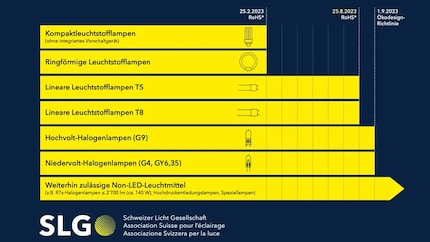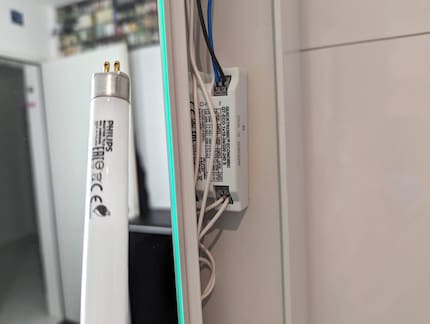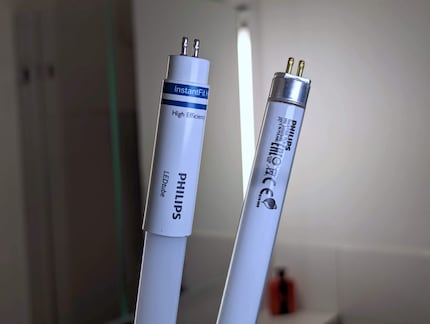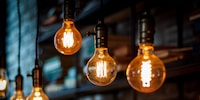

A painstaking conversion: lights off for conventional fluorescent bulbs
As of the end of August, there will be no more fluorescent tube lights. This means that bathroom, basement and kitchen lights must be replaced with LED alternatives. Which can be expensive.
Incandescent bulbs have been banned since 2012 – we all replaced them with LED bulbs easily enough. In 2021, most halogen models were also blacklisted. This year, the same fate has befallen widely used T5 and T8 fluorescent tubes (in German.)
These often illuminate basements, stairwells, garages, industrial plants, companies and shops and are also often installed in kitchens and bathrooms. Fluorescent tube lighting will no longer be made for the EU and Switzerland from the end of August. Only remaining stock can be sold.

Source: Schweizer Licht Gesellschaft (Swiss Light Society)
Incidentally, this isn’t because their energy efficiency is considerably worse, as is the case with light bulbs; it’s because light sources containing mercury have been banned. And as mercury gas is ignited in the tubes, the fate of this technology is sealed. There are, of course, alternatives – including tubes fitted with LEDs. In the medium term, we all have no choice and will have to replace all conventional fluorescent tubes sooner or later.
After all, LEDs have other advantages in addition to their mercury-free design. They use 65 per cent less electricity and the new tubes now last 50,000 to 75,000 hours instead of 6,000 to 15,000 hours. LEDs are also easier to dim and control. But the old tubes radiate all around, while about a quarter of the surface of LEDs usually don’t light up.
Simply screwing in LED tubes doesn’t always work
The main disadvantage of the new tubes is that, while any suitable LED bulb can simply be screwed into its socket, the tubes are much more complicated. This makes converting them a lot more effort.

Source: Lorenz Keller
The first thing to do is find the right tube. Buying the wrong one can be painful, with LED tubes costing 20 to 30 francs apiece – conventional tubes only cost a few francs. Philips has published a 34-page PDF with a compatibility list. This shows that things aren’t that simple.
The gas in the old fluorescent tubes has to be «ignited» by a starter. There are three different types on the market: conventional ballasts and low-loss ballasts are often found in the large T8 tubes, screwed directly into the bulb socket as a kind of small fuse. When switching to LED, the starter has to be replaced with a supplied dummy as it’s no longer needed. Incidentally, conventional ballasts and low-loss ballasts are often easy to recognise from the short, typical flickering of the fluorescent tubes when they’re switched on.

Source: Lorenz Keller
Electronic ballasts are more modern, more efficient and often control several tubes at the same time. However, if you screw in the right LED tubes, you could get a nasty surprise. For example, that the control doesn’t manage to switch off all the lights. Or that individual tubes flicker.
If a professional is required, things get expensive
If you’re not very familiar with electrical engineering, you’ll need a specialist to replace the control unit and make any modifications. A mirror cabinet with three tubes, for example, costs around 300 francs. An underground car park with dozens of lights quickly adds up to thousands.

Source: Lorenz Keller
At least tenants aren’t saddled with these costs. According to the tenants’ association, landlords must cover the conversion costs if the lights are part of the building. For example, a built-in light in the kitchen, a light in a mirrored cabinet or fluorescent lighting in the basement.
Whether you’re a tenant or an owner, it’s worth addressing the issue earlier rather than later. You don’t want to be left in the dark from autumn because the old fluorescent tubes have suddenly sold out – or no installation companies have any appointments available anymore.
Header image: Lorenz Keller
Gadgets are my passion - whether you need them for the home office, for the household, for sport and pleasure or for the smart home. Or, of course, for the big hobby next to the family, namely fishing.
Interesting facts about products, behind-the-scenes looks at manufacturers and deep-dives on interesting people.
Show allThese articles might also interest you

Background information
If you can no longer see the light because of all the lamps, a buying guide will come from somewhere
by Natalie Hemengül

Background information
A mobile's final journey (part 2): how harmful substances are disposed of safely
by Martina Huber

Product test
Hit or shit? LED toilet light review
by Martin Jud




